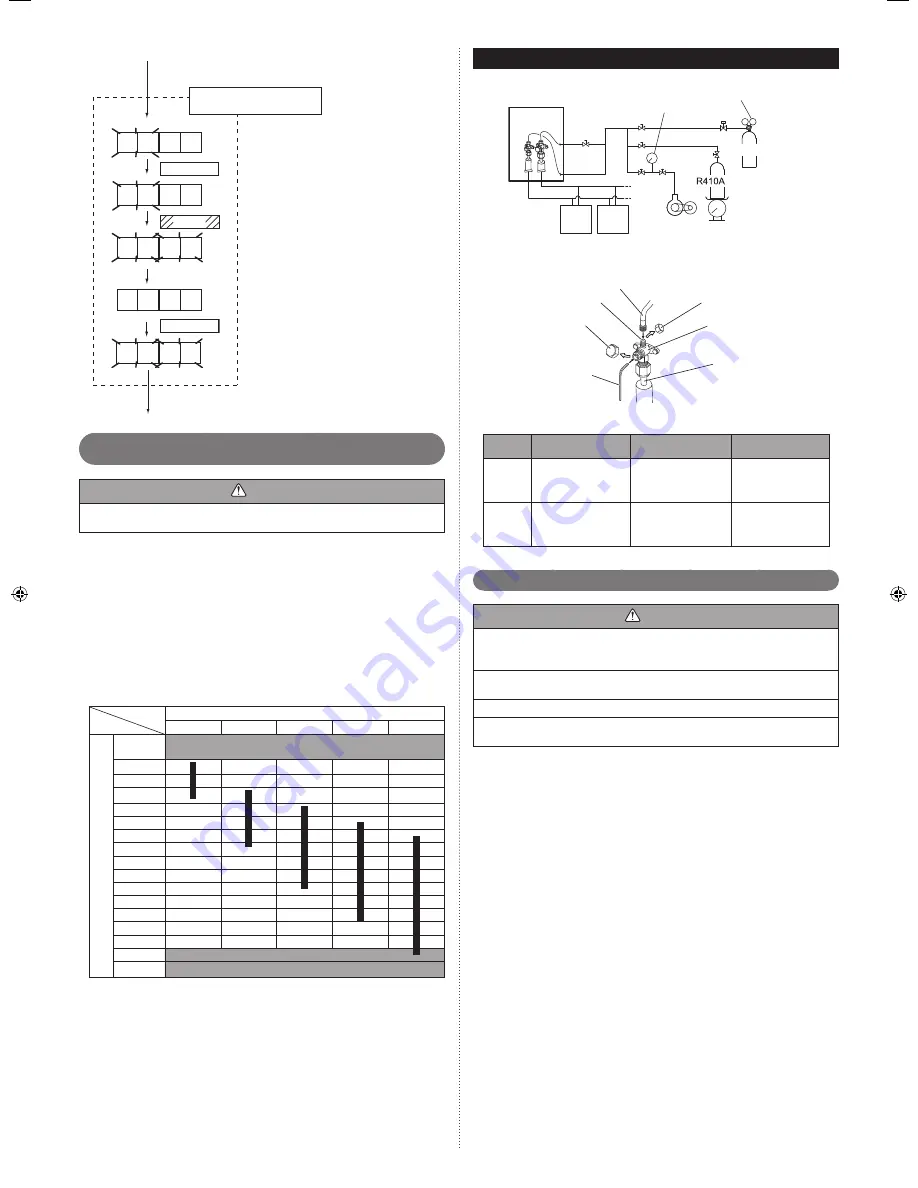
En-17
PIPE INSTALLATION II
8.
A Connection system
Fig.
Outdoor unit
Pressure gauge
Vacuum
pump
Scale
Pressure regulating valve
Nitrogen
Indoor
unit
Indoor
unit
B
Fig.
Service hose with valve core
Charging port
Charging port cap
3-way valve
Connecting pipe
Blank cap
Hexagon wrench
4mm (5/32")
A
Table.
Pipe
3-way valve
Blank cap
Charging port cap
Liquid
valve
7.0 to 9.0 N·m
(70 to 90 kgf·cm)
20.0 to 25.0 N·m
(200 to 250 kgf·cm)
12.5 to 16.0 N·m
(125 to 160 kgf·cm)
Gas
valve
11.0 to 13.0 N·m
(110 to 130 kgf·cm)
30.0 to 35.0 N·m
(300 to 350 kgf·cm)
12.5 to 16.0 N·m
(125 to 160 kgf·cm)
Sealing test
8. 1.
CAUTION
Use only nitrogen gas.
Never use refrigerant gas, oxygen, in
fl
ammable gas or poisonous gas to pressurize
the system. (If oxygen is used, there is the danger of an explosion.)
Do not apply shock during sealing test.
It can rupture the pipes and cause serious injury.
Do not turn on the power unless all operations are complete.
Do not block the walls and the ceiling until the sealing test and the charging of the
refrigerant gas have been completed.
After connecting the pipes, perform an sealing test.
Recheck that the 3-way valve are closed before performing a sealing test.
(Fig. B)
Pour nitrogen gas through both the liquid pipe and the gas pipe.
Pressurize nitrogen gas to 4.2 MPa to perform the sealing test.
Check all
fl
are connection areas and brazed areas.
Then, check that the pressure has not decreased.
Compare the pressures after pressurizing and letting it stand for 24 hours, and check
that the pressure has not decreased.
When the outdoor temperature changes 5 °C, the test pressure changes 0.05 MPa.
*
If the pressure has dropped, the pipe joints may be leaking.
If a leakage is found, immediately repair it and perform a sealing test again.
* Decrease the pressure of nitrogen gas before blazing
After completing the sealing test, release the nitrogen gas from both valves.
Release the nitrogen gas slowly.
It may take about 10 minutes for completing
the processing.
End
1
@
@
> >
4
4
ﻸ
ﻮ ﻮ
ﻮ ﻮ
ﻺ ﻶ
First 2 digits Last 2 digits
Press the “SELECT” button until
“11” is displayed.
Press the “ENTER” button for more
than 3 seconds.
Automatic address setting
for indoor units
@
@
The number of indoor units with normal set-
tings will be displayed at the
fi
rst 2 digits of
the 7 segment display. The number of indoor
units with error will be displayed at the last 2
digits.
NOTE) After the “ENTER” button is pressed, the
end processing will occur for about 30 seconds.
During this period, the 7 segment will blink.
ENTER
SELECT
ENTER
Resistance measurement of transmission cable
7. 7.
(Measure with breaker OFF)
CAUTION
Do not turn on the power if the resistance between the terminals of the transmission
cable is abnormal. Otherwise, the PC board may be damaged.
Measure the resistance between 2 terminals of a transmission cable.
Transmission cable connecting indoor units, outdoor units, and signal ampli-
(1)
fi
ers
Measure the resistance of the signal ampli
fi
er terminal and the terminal of the indoor
and outdoor units connected farthest away from the device where terminal resistor
is measured.
A value from the table is displayed, depending on the distance from the signal ampli-
fi
er and the device where the terminal resistor is set.
This value is an estimate.
Transmission cable connecting outdoor units in a refrigerant system
(2)
The resistance between the terminals of the transmission cable is 45-60
Ω
.
This value is an estimate.
Distance from termination resistor (m)
0 ~100
~ 200
~ 300
~400
~500
Approximate resistance (
Ω
)
0 ~ 50
A short circuit somewhere or 2 or more termination resistors are
connected
50
60
70
80
90
100
110
120
130
140
150
160
170
180
190 ~
Faulty contact or wiring length over 500 m
1K ~
∞
Faulty contact, open circuit, or no termination resistor
9380545026-02_IM.indb 17
9380545026-02_IM.indb 17
19/08/2013 17:20:09
19/08/2013 17:20:09






































